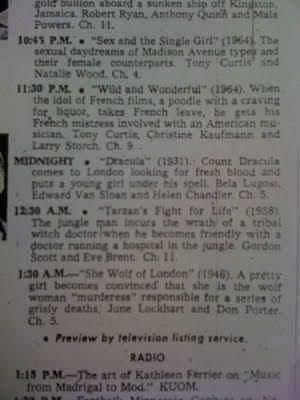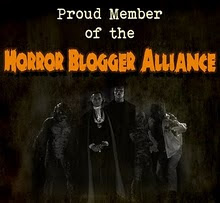Synopsis: Renfield (Dwight Frye), a young attorney from London, arrives at a small Carpathian village. His fellow travelers are staying in the village overnight but he insists on continuing on to the castle of a local nobleman, Count Dracula (Bela Lugosi).
The villagers turn pale at the very mention of the name, and beg him not to go. But Renfield is there on business, and insists on completing his journey.
After an unnerving trip to the castle, Renfield finally meets the count, who signs documents to complete his purchase of Carfax Abbey in England. It is to England, Dracula says, that he will go the very next morning.
Later, a ship drifts into an English harbor, all aboard her dead -- save for Renfield, who is now a stark, raving lunatic.
Several crates from the ship are delivered to Carfax Abbey. From one of them emerges Count Dracula, who soon insinuates himself into London society, befriending Dr. Seward, owner of the Seward Asylum where Renfield is confined. The asylum is, we learn, next door to Carfax Abbey. Dracula meets Dr. Seward's daughter, Mina (Helen Chandler); her fiancee Jonathan Harker (David Manners), and their friend Lucy (Frances Dade).
Meanwhile, a string of bizarre murders has caught the interest of Dr. Van Helsing (Edward Van Sloan), an unorthodox scientist and student of the occult. Two small puncture wounds, he finds, were on the necks of each victim, including young Lucy.

When Mina relates a dream of a man coming into her bedroom and biting her neck, Seward is surprised to see that Mina has been hiding two small puncture wounds herself. But Van Helsing is not surprised. He insists that a vampire is attempting to make Mina its slave by visiting her over a series of subsequent nights.
Mina can only be protected, he says, by locking her in her room, and sealing the windows with wolfbane and crucifixes, which vampires find repellent.
Meanwhile, Count Dracula pays a visit to the Seward home, and Van Helsing quickly realizes that Dracula himself is the vampire they seek. A battle of wits ensues, with Van Helsing battling Count Dracula for Mina's very soul....
Comments: Dracula was the first movie to be broadcast twice on Horror Incorporated, and tonight it becomes the first to be broadcast three times.
You may remember that Horror Incorporated first aired this movie the night of its premiere on November 8, 1969. We saw it again on August 22. Having it pop up again, for the third time in a single year, makes me wonder if we're getting too much of a good thing.
And it raises a question that I've been asked a few times since I started this project: how do we know for sure what was running on a particular date?
The short answer is: we can't be 100% certain. We're going by the broadcast schedules printed in the Minneapolis Tribune. And those of us who remember the olden days of newspaper TV schedules know that they were occasionally wrong.
But one advantage to having your show in the middle of the night was that it was harder to get pre-empted. Horror Incorporated wasn't about to get bumped by special programming -- for example, the American League playoffs, in which Minnesota was battling against the Baltimore Orioles for the pennant, interrupted a lot of programming on October 3, 1970.*
But Horror Incorporated was able to saunter on, oblivious to the mayhem farther up the program grid. So I'd say that if there was an error in the listing, it would be due to a mistake in the newspaper, not because the show was pre-empted due to an 11-inning ball game, or because the President suddenly got a yen to address the nation from the Oval Office.
Having said that, it's certainly not inconceivable that Dracula ran three times in one year.
Obviously, I'd prefer a back-up source of information -- videotape archives of the show, station memos or other documents referencing the movies on the schedule, etc.
I have been trying to obtain such documents, but let's face it: local, non-hosted late-night creature features were never seen as likely candidates for historic preservation. I'm sure much of what I am looking for was routinely tossed out by the station when it was no longer useful. But I will keep trying.
Anyway, I'm not complaining about seeing Dracula again. If you're going to see any movie three times in a year, it might as well be this one. It holds up surprisingly well on repeat viewing, though I would say that it is best in its first and final thirds, sagging somewhat in the talky second act.
Interestingly, Dr. Van Helsing stands as the perfect counterpoint to Bride of Frankenstein's Dr. Pretorious. Pretorious is an amoral scientist who turns to the occult in order to gain knowledge and abilities that science cannot offer; while Van Helsing is a deeply moral scientist who studies the occult in order to battle its evils. It's a pity the two characters didn't get a chance to face off in a movie of their own. It would have been interesting to see what each would have made of the other's curriculum vitae.
And just because you asked, here is the Castle Films version of Dracula -- pared down to within an inch of its unnatural life.
_______________________________
* In case you're curious, the heavily-favored Orioles swept the Twins in the best-of-five series, then went on to defeat the Cincinnati Reds four games to one in the World Series. In 1970 there were two divisions per league, so division winners had only one best-of-five series between them and the pennant.
She-Wolf of London

Synopsis: Young Phyllis Allenby (June Lockhart) is preparing for her marriage to attorney Barry Lanfield (Don Porter). Barry is the perfect candidate for marriage: handsome, patient, understanding, and (last but not least) wealthy. But Phyllis is deeply troubled, because a bizarre series of murders has been taking place in the park near the Allenby estate. The method of the killings suggest an animal attack, and Phyllis mutters fearfully about a return of the "Allenby Curse".
Meanwhile, Phyllis' cousin Carol Winthrop (Jan Wiley) is caught by her mother, Martha Winthrop (Sara Haden) trying to send a letter to a boyfriend across town. Martha warns Carol that she can never have anything to do with young Dwight Severn (Martin Kosleck), reminding her that Dwight is penniless. She reveals something that no one else seems to know -- that neither she nor Carol is related by blood to Phyllis Allenby. Martha has been the family housekeeper for decades and it is now taken on faith that she and Carol are members of the family.
Now that Phyllis is the sole remaining heir of the Allenby estate, Martha and Carol are in a precarious position, at risk of losing everything -- if Phyllis marries. But if Carol were to marry Lanfield instead, matters would improve considerably for both Carol and Martha.

Unorthodox Detective Latham of Scotland Yard is convinced that the park murders are the work of a werewolf, a theory rejected by hidebound Inspector Pierce (Dennis Hoey). In fact, the only person who seems to buy into the werewolf theory is Phyllis herself, who explains to Aunt Martha that the Allenby Curse dooms members of her family to turn into ravenous wolves, an affliction for which there is no cure.
Aunt Martha tries to convince Phyllis that it's all in her head, but Phyllis knows that each morning her slippers are caked with mud, her dress sodden and torn, and her hands covered with blood.
Fearful of the creature that she has become, she breaks off her engagement with Barry. But Barry refuses to believe in the curse, or in Phyllis' guilt, and he is determined to unmask the real she-wolf of London....
Comments: In my previous write-up of She-Wolf of London I noted that the film was an amalgamation of two popular suspense pictures of the early 1940s: Cat People and Gaslight. On a second viewing, She-Wolf of London might best be described as Cat People's premise melded with Gaslight's ending. As in Cat People, Phyllis is worried about her impending marriage to Barry because she is convinced she turns into a vicious animal, as predicted by her family's curse. But, like Gaslight, it turns out that this is all a set-up, perpetrated by her closest confidante.
This isn't a bad idea, actually, but She-Wolf of London falls apart on execution, for three critical reasons.
The first, and most egregious, is the that the screenplay cheats the audience. When you promise a she-wolf (in the title, no less) you'd damn well better come up with a she-wolf, either literally (woman turns into ravenous wolf) or figuratively (woman is predatory in her behavior, demeanor or appetites).
I asked my friend Shakira to throw a video together demonstrating this second definition of she-wolfery, and she kindly agreed:
Second, the Allenby curse is repeatedly invoked, and evidence is given for us to believe it (the crazed way dogs react to Phyllis, for example); but once Aunt Martha is identified as the killer, everyone agrees that the Allenby curse was just a lot of superstitious nonsense. Some of Phyllis' evidence for the curse is explained away by Martha's actions (the muddy boots and blood-stained hands), but everything else is conveniently forgotten.
The third problem that undercuts She-Wolf of London is its dreadful cheapness. The C-list cast is clearly racing through the shooting schedule, and there is no time to build atmosphere, suspense, or even convincing English accents. A very young June Lockhart has neither the screen presence nor the acting chops to carry the movie effectively, and she isn't aided by the colorless studio contract players surrounding her. Martin Kosleck, who is always interesting to watch, has little more than a cameo here.
Castle Films, it should be noted, apparently didn't think She-Wolf of London warranted an 8-minute version. I can't say I'm surprised.










